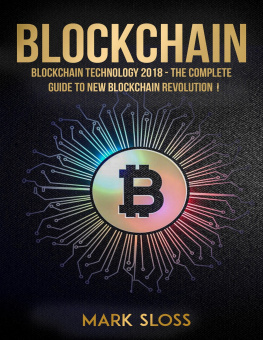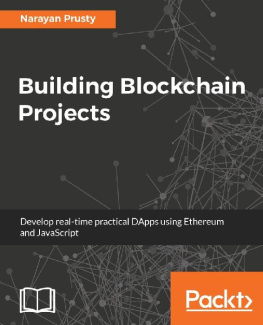Narayan Prusty [Narayan Prusty] - Blockchain for Enterprise
Here you can read online Narayan Prusty [Narayan Prusty] - Blockchain for Enterprise full text of the book (entire story) in english for free. Download pdf and epub, get meaning, cover and reviews about this ebook. year: 2018, publisher: Packt Publishing, genre: Romance novel. Description of the work, (preface) as well as reviews are available. Best literature library LitArk.com created for fans of good reading and offers a wide selection of genres:
Romance novel
Science fiction
Adventure
Detective
Science
History
Home and family
Prose
Art
Politics
Computer
Non-fiction
Religion
Business
Children
Humor
Choose a favorite category and find really read worthwhile books. Enjoy immersion in the world of imagination, feel the emotions of the characters or learn something new for yourself, make an fascinating discovery.
- Book:Blockchain for Enterprise
- Author:
- Publisher:Packt Publishing
- Genre:
- Year:2018
- Rating:4 / 5
- Favourites:Add to favourites
- Your mark:
Blockchain for Enterprise: summary, description and annotation
We offer to read an annotation, description, summary or preface (depends on what the author of the book "Blockchain for Enterprise" wrote himself). If you haven't found the necessary information about the book — write in the comments, we will try to find it.
Implement blockchain principles in your choice of domain using Ethereum
Key Features- Build permissioned enterprise-grade blockchain applications from scratch
- Implement Blockchain-as-a-Service to enterprises in terms of deployment and security
- Achieve privacy in blockchains using proxy re-encryption algorithms
The increasing growth in blockchain use is enormous, and it is changing the way business is done. Many leading organizations are already exploring the potential of blockchain. With this book, you will learn to build end-to-end enterprise-level decentralized applications and scale them across your organization to meet your companys needs.
This book will help you understand what DApps are and how the blockchain ecosystem works, via real-world examples. This extensive end-to-end book covers every blockchain aspect for business and for developers. You will master process flows and incorporate them into your own enterprise. You will learn how to use J.P. Morgans Quorum to build blockchain-based applications. You will also learn how to write applications that can help communicate enterprise blockchain solutions. You will learn how to write smart contracts that run without censorship and third-party interference.
Once youve grasped what a blockchain is and have learned about Quorum, you will jump into building real-world practical blockchain applications for sectors such as payment and money transfer, healthcare, cloud computing, supply chain management, and much more.
What you will learn- Learn how to set up Raft/IBFT Quorum networks
- Implement Quorums privacy and security features
- Write, compile, and deploy smart contracts
- Learn to interact with Quorum using the web3.js JavaScript library
- Learn how to execute atomic swaps between different networks
- Build a secured Blockchain-as-a-Service for efficient business processes
- Achieve data privacy in blockchains using proxy re-encryption
This book is for innovators, digital transformers, and blockchain developers who want to build end-to-end, decentralized applications using the blockchain technology. If you want to scale your existing blockchain system across the enterprise, you will find this book useful, too. It adopts a practical approach to solving real problems in enterprises using a blend of theory and practice.
Downloading the example code for this book You can download the example code files for all Packt books you have purchased from your account at http://www.PacktPub.com. If you purchased this book elsewhere, you can visit http://www.PacktPub.com/support and register to have the files e-mailed directly to you.
Narayan Prusty [Narayan Prusty]: author's other books
Who wrote Blockchain for Enterprise? Find out the surname, the name of the author of the book and a list of all author's works by series.

![Narayan Prusty [Narayan Prusty] Blockchain for Enterprise](/uploads/posts/book/119699/thumbs/narayan-prusty-narayan-prusty-blockchain-for.jpg)







